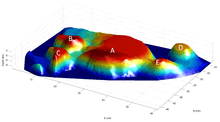North Pennine Batholith
The North Pennine Batholith, also known as the Weardale Granite is a granitic batholith lying under northeast England, emplaced around 400 million years ago in the early Devonian.[2] The batholith consists of five plutons, the Tynehead, Scordale, Rowlands Gill, Cornsay and Weardale plutons. The Weardale Granite pluton is the largest and the only one that has been proved (sampled), after the Rookhope Borehole confirmed Martin Bott's hypothesis that a large negative gravity anomaly under Weardale represented a low-density igneous intrusion.[3]
| North Pennine Batholith Stratigraphic range: Early Devonian | |
|---|---|
 | |
| Type | Batholith |
| Unit of | Northern England Devonian Plutonic Suite[1] |
| Thickness | 10 km (at maximum) |
| Lithology | |
| Primary | Granite |
| Location | |
| Region | Northeastern England |
| Country | United Kingdom |
History of Study
In 1934, Kingsley Dunham published a paper proposing that ore deposits in the Alston Block were formed due to a granite intrusion beneath Weardale.[4] This was later tested by a gravity survey, which found a large negative gravity anomaly, supporting the hypothesis.
In the early 1960s, a borehole was drilled at Rookhope by Durham University, and proved the existence of the intrusion at a depth of 390 m.[5] The intrusion was found to have a weathered top, so couldn't account for the mineralisation that was the basis of the hypothesis that first suggested its existence.
In 2004, a second borehole was drilled in Eastgate, and the granite was reached at 270 m below the surface[6]
See also
- Whin Sill, another large igneous intrusion in northeast England.
References
- "Northern England Devonian Plutonic Suite". BGS Lexicon of Named Rock Units. British Geological Survey. Retrieved 2 June 2018.
- Kimbell, G.S., B. Young, D. Millward and Q. G. Crowley (2010). 'The North Pennine batholith (Weardale Granite) of northern England: new data on its age and form', Proceedings of the Yorkshire Geological Society 58, 107-128; doi:10.1144/pygs.58.1.273
- Bott, M.H.P (2003), 'The story of the Weardale granite', OUGS Journal 24, 39-43 Link to PDF.
- Dunham, K.C. (1934), 'The genesis of the north Pennine ore deposits', Quarterly Journal of the Geological Society of London 90, 689-720; doi:10.1144/GSL.JGS.1934.090.01-04.23
- Dunham K.C., G.A.L. Johnson, M.H.P. Bott and B.L. Hodge (1961), 'Granite beneath the Northern Pennines', Nature 190, 899 - 900 '; doi:10.1038/190899a0
- Manning D.A.C., P.L. Younger, F.W. Smith, J.M. Jones, D.J. Dufton and S. Diskin (2007), 'A deep geothermal exploration well at Eastgate, Weardale, UK: a novel exploration concept for low-enthalpy resources', Journal of the Geological Society, London 164, 371–382; doi:10.1144/0016-76492006-015